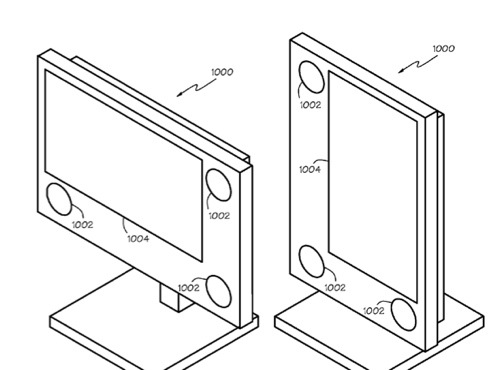Apple may be working on new speaker technology for Macs and/or its iOS devices. An Apple patent (number 20110002487) for a has appeared at the US Patent & Trademark Office. Embodiments of the invention relate to the field of audio output; and more specifically, to routing audio channels to multiple speakers in a movable device.
The patent involves a device that provides an audio output and includes a speaker array mechanically fixed to the device. The speaker array includes at least three speakers. An orientation sensor detects an orientation of the speaker array and provides an orientation signal. An audio receiver receives a number of audio signals that include spatial position information. An audio processor is coupled to the speakers, the orientation sensor, and the audio receiver.
The audio processor receives the audio signals and the orientation signal, and selectively routes the audio signals to the speakers according to the spatial position information and the orientation signal such that the spatial position information is perceptible to a listener. The orientation signal may be provided by a compass, an accelerometer, an inertial sensor, or other device. The orientation signal may be provided according to selection of display orientation, shape of touch input, image recognition of the listener, or the like. The inventors are Heiko Panther, David Julian and Roberto G. Yepez.
Here’s Apple’s background and summary of the invention: “People generally have a well-developed ability to localize the position of a sound source based on the differences in the way the sound is heard by their two ears. In sound reproduction sound may be recorded in two or more channels of audio material and routed to multiple speakers to provide sound cues that allow the listener to localize the apparent position of the recorded sound in much the same way as the original source could be localized. It is necessary for the listener to be located correctly with respect to the speakers for the spatial position information in the sound reproduction to be perceptible to the listener and permit localization of sound sources in the sound as reproduced by the speakers. Similar considerations apply to synthesized audio material that may be routed to multiple speakers to provide an illusion of localized sound sources.
“Audio devices that move with respect to the listener create a challenge for the reproduction of multichannel audio using multiple speakers because the spatial relationship between the listener and the speakers can change and interfere with the listener’s perception of the spatial position information. It would be desirable to provide an audio device with multiple speakers that can reproduce multichannel audio material in a way that makes the spatial position information perceptible to the listener while allowing the audio device to move with respect to the listener.
“A device that provides an audio output includes a speaker array mechanically fixed to the device. The speaker array includes at least three speakers in a non-collinear arrangement. An orientation sensor detects an orientation of the speaker array and provides an orientation signal. An audio receiver receives a number of audio signals that include spatial position information. An audio processor is coupled to the speakers, the orientation sensor, and the audio receiver.
“The audio processor receives the audio signals and the orientation signal, and selectively routes the audio signals to the speakers according to the spatial position information and the orientation signal such that the spatial position information is perceptible to a listener. The orientation signal may be provided by a compass, an accelerometer, an inertial sensor, or other device. The orientation signal may be provided according to selection of display orientation, shape of touch input, image recognition of the listener, or the like.”
— Dennis Sellers





